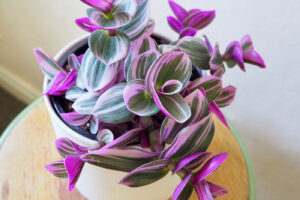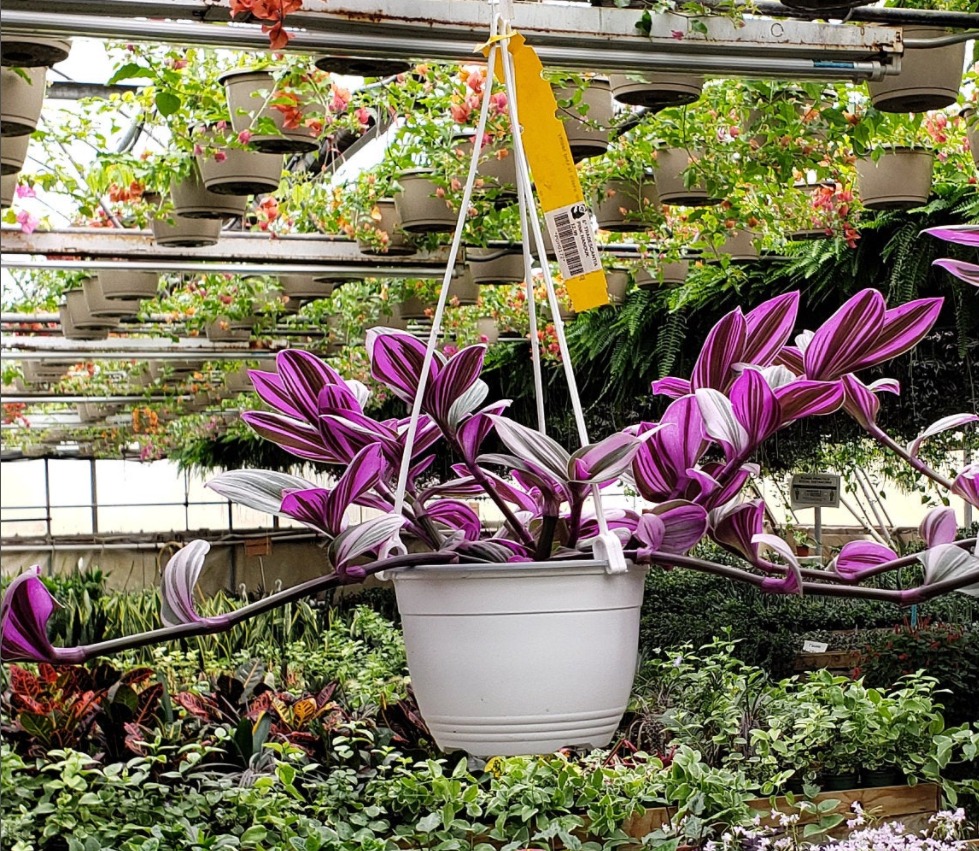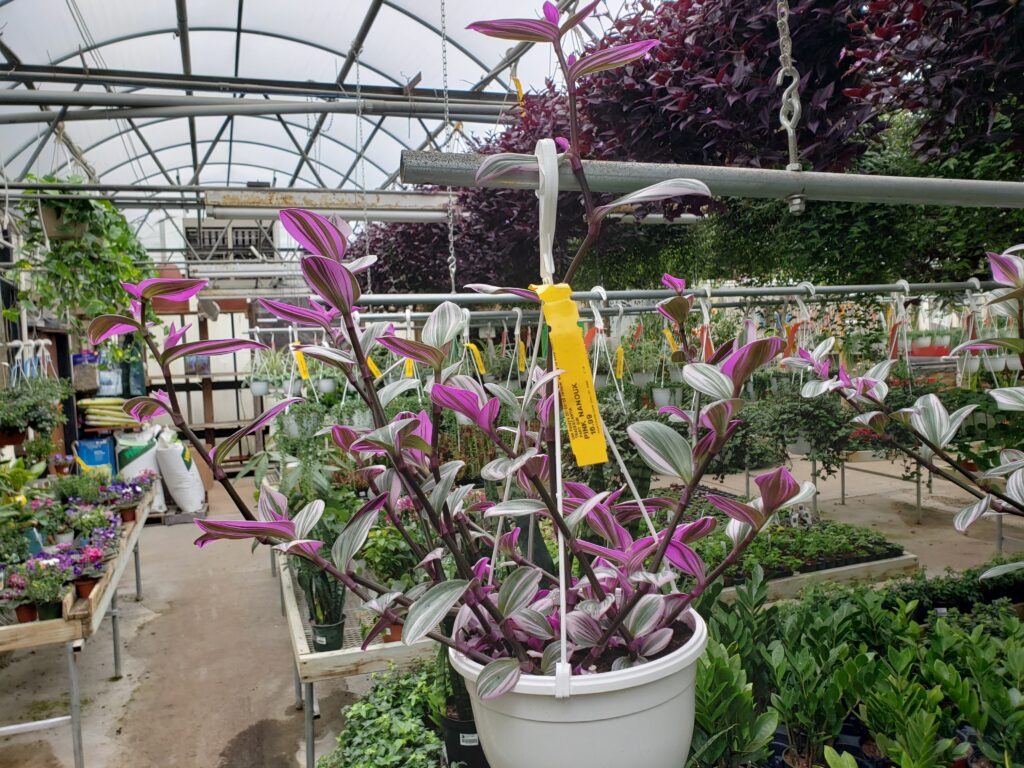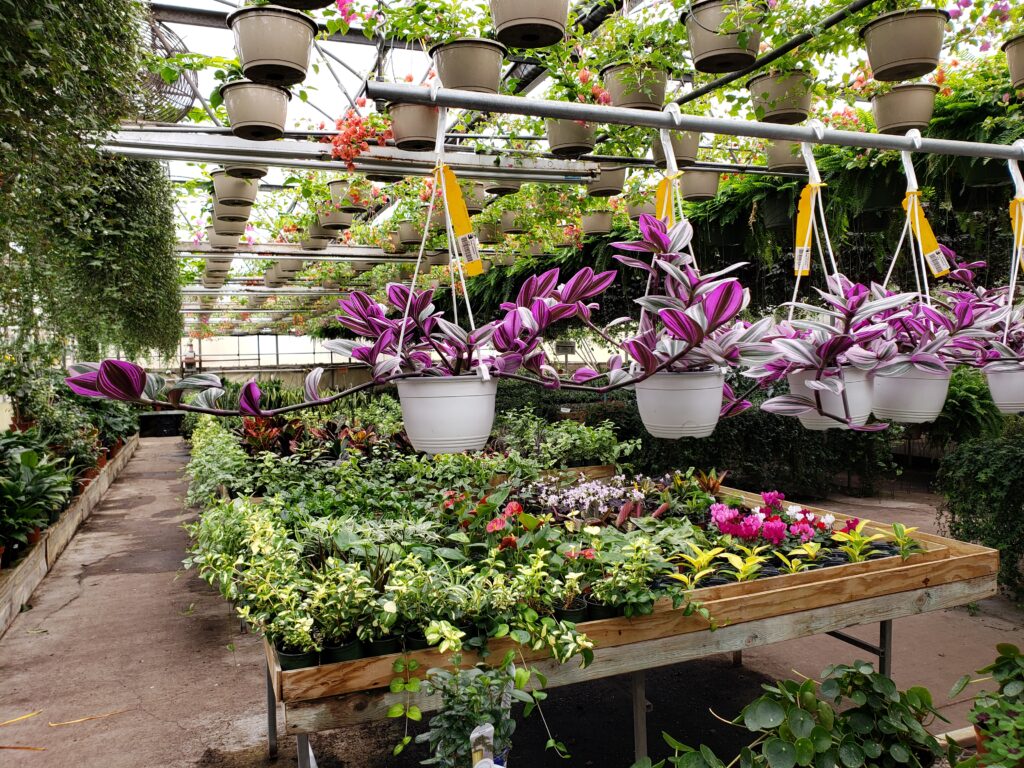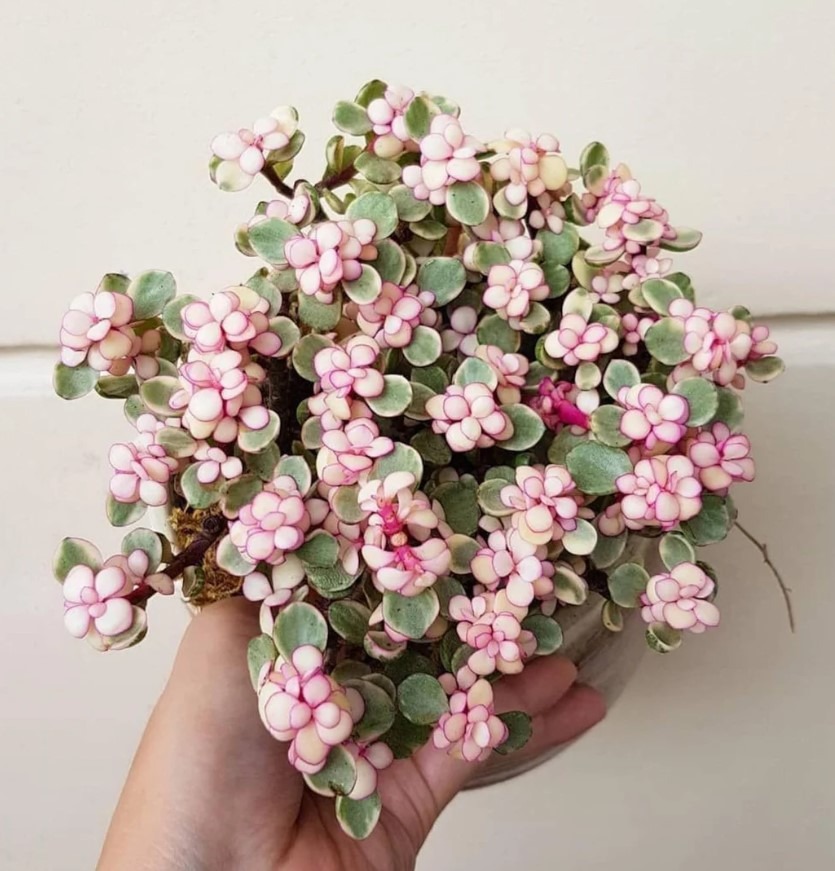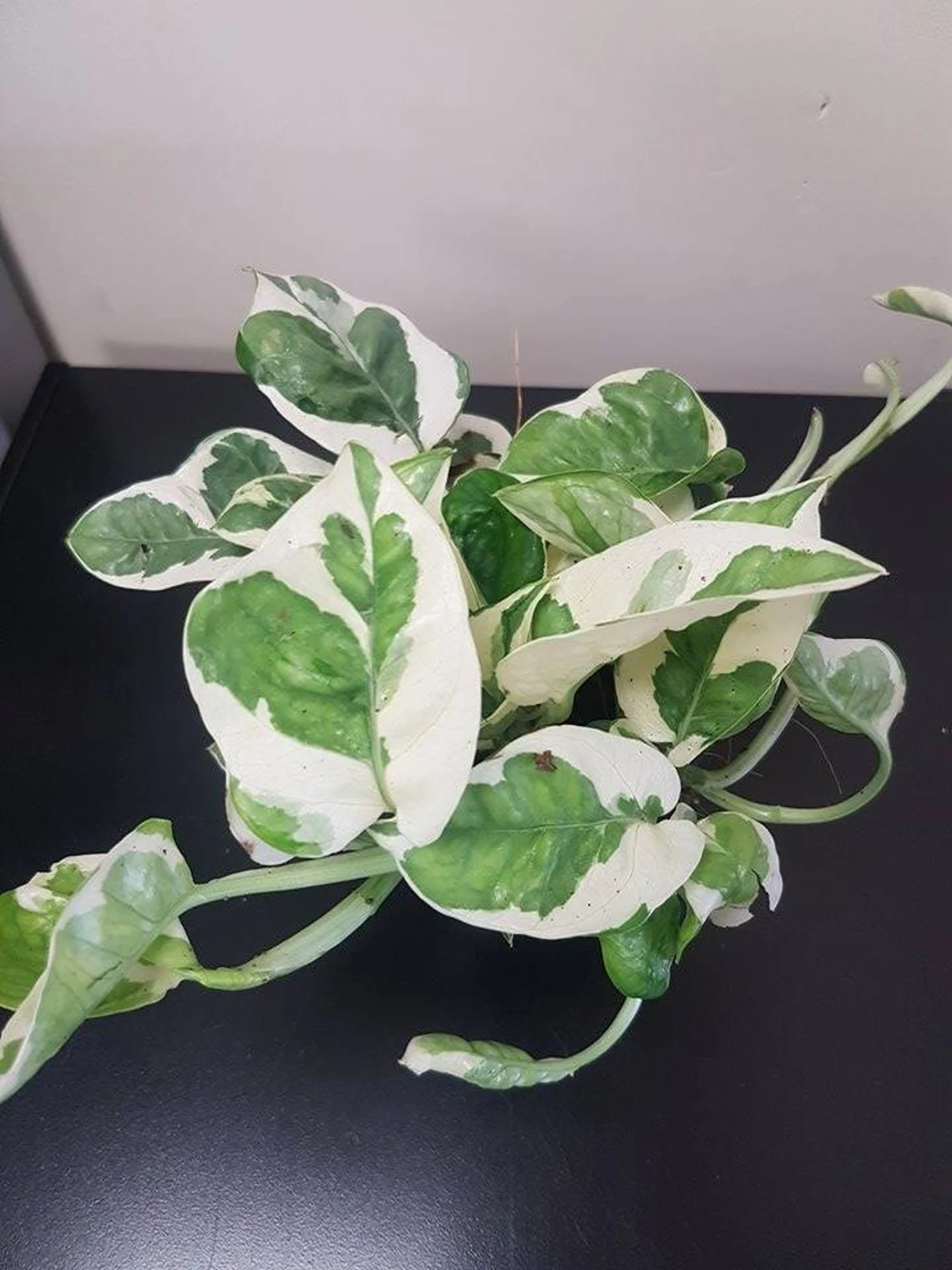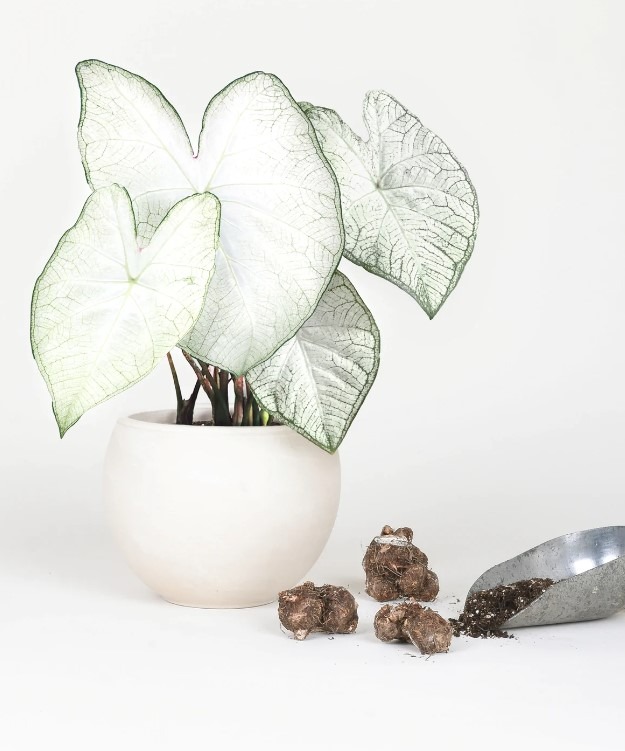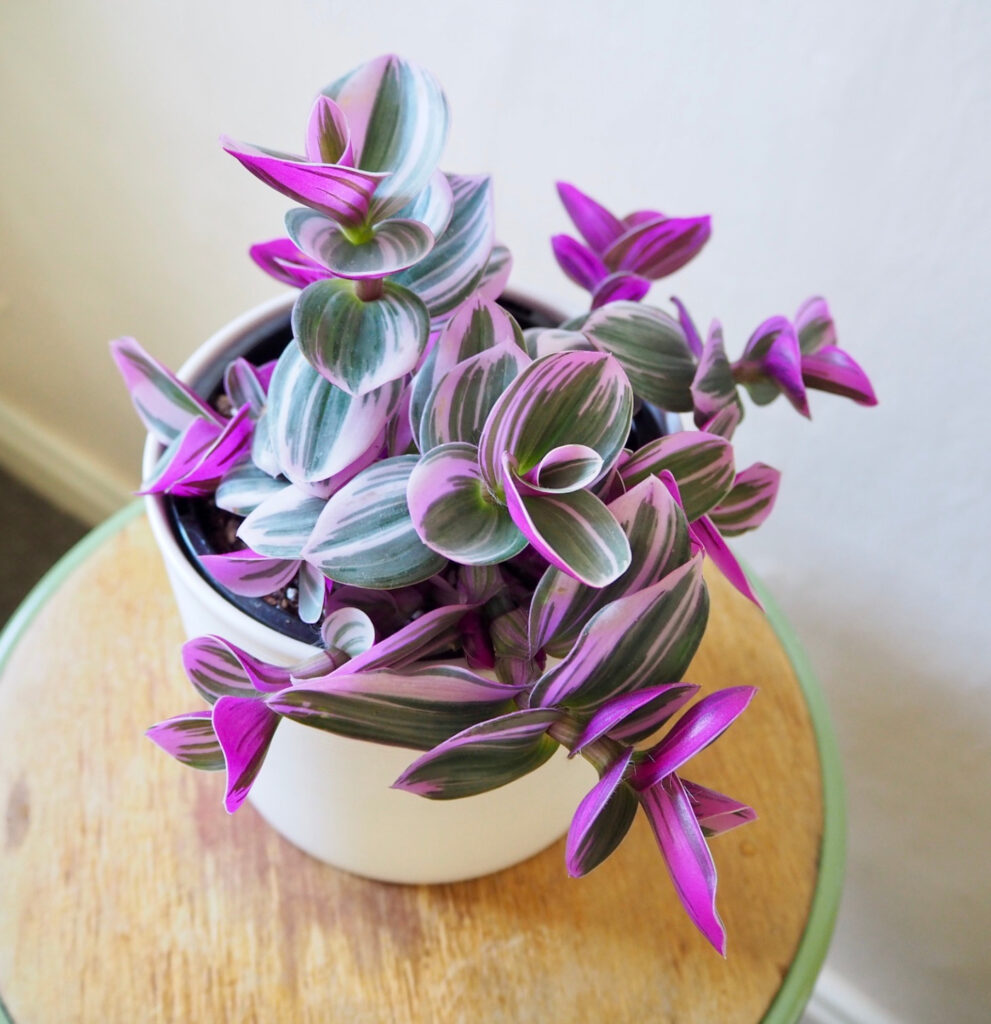
Tradescantia Nanouk (Wandering Jew) is very low maintenance when it comes to houseplants.
Home Decor Plants
It is wonderfully attractive as a live focal point for your living room and it does not particularly need to be watched like a hawk.
You can be confident, as the busy person you are, that it will not go dying on you anytime soon!
The Pink Nanouk is easy to care for and since its lack of TLC goes unnoticed, you can be confident it will be just fine when you return home from your travels.
If you want to spice up your home or apartment with a live rare beauty give this one a try.
Tradescantia is hardy and It can also be grown outdoors in warmer climates but most people chose to decorate using the nanouk as home decor.
Where to buy Tradescantia Nanouk?
Tradescantia Nanouk for Sale
Tradescantia Nanouk for sale and it is becoming more easier to find these days. A place we recommend is Etsy or Amazon. Amazon is a little bit higher on pricing right now.
Ok, once you have found your new plant it is time to get you some care instructions!
Tradescantia Nanouk Care | Tradescantia Planting Directions
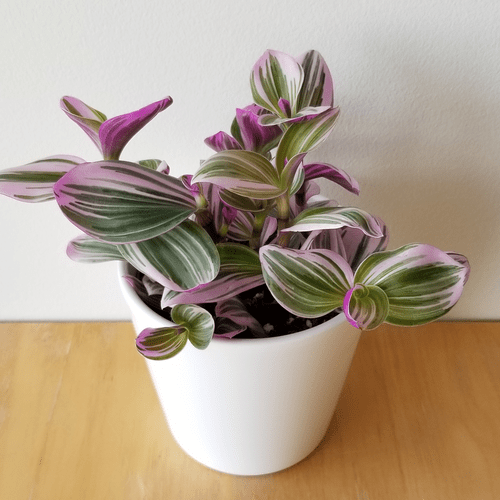
How to Grow Tradescantia Pink Nanouk
Care Instructions:
Watering and Moisture
Water your Tradescantia Nanouk when the top inch or so of soil is dry, but take care not to let the plant completely dry out.
It’s ideal to water the soil directly so that you avoid getting the area between the leaves wet, which can cause the plant to rot.
Your Tradescantia Nanouk will grow best in a humid environment because of it’s natural habitat.
Light
Your plant will like a bright and filtered light area of your home. It does not need direct sunlight. In fact, it does not like direct sunlight.
Since your Nanouk enjoys indirect sun a good place for it to grow would be a room that has windows where daylight is present for 8 hours.
So if you live in the United States this will be on the southern side of your house.
Temperature
The ideal temperature for the Nanouk Tradescantia cultivar is between 55° and 75° degrees Fahrenheit.
Outdoors, this Tradescantia is winter hardy in USDA hardiness zones 10 through 12.
If you do not live in a tropical zone you can bring in your plant and place in a bight warm spot throughout the winter.
Repotting Tradescantia
When it is time to repot your Tradescantia Pink Nanouk you will want to chose a pot that is at least double the size of the root ball.
This allows for the roots to re-establish themselves to support new growth.
To enhance drainage, it’s a good idea to add a few handfuls of perlite, orchid bark, or coarse sand to the mix.
Be sure to use a pot or container with a hole in the bottom for drainage.
Soil
Use a standard well-draining houseplant soil when planting your Nanouk. Some may disagree, but really the soil is not a big concern.
Tradescantia will thrive in pretty much anything that drains well and does not leave sitting or standing water for a period of time.
Fertilizer
Feeding and fertilizing your Pink Nanouk can be done in the Spring until Summer time. This is the normal growing period for them and it’s when you will see the most substantial growth.
You may even see a few triangular flowers too!
We do not fertilize our Tradescantia. Rather, we use a high grade potting mix and when it is time to repot, we then use the high grade mix again.
Again, this is a very low maintenance plant and if you give it good growing conditions as listed above you will enjoy it’s beauty for many years to come.
How to make Tradescantia nanouk Bushy
Pruning
Many ask where to cut Tradescantia nanouk at?
Tradescantia Nanouk pruning is necessary if you want a full bushy like houseplant. You can take a pair of scissors which works best and cut right above a leave node.
This will help the plant to push out another stem or two right from the leaves just below where you trimmed off the top part at.
You can then transplant the cuttings into the soil and they will root in about 3 weeks.
Does Tradescantia nanouk Trail
Yes, if you leave it growing long enough. Especially, in a hanging basket the tradescantia nanouk will begin to trail down as a vine would do.
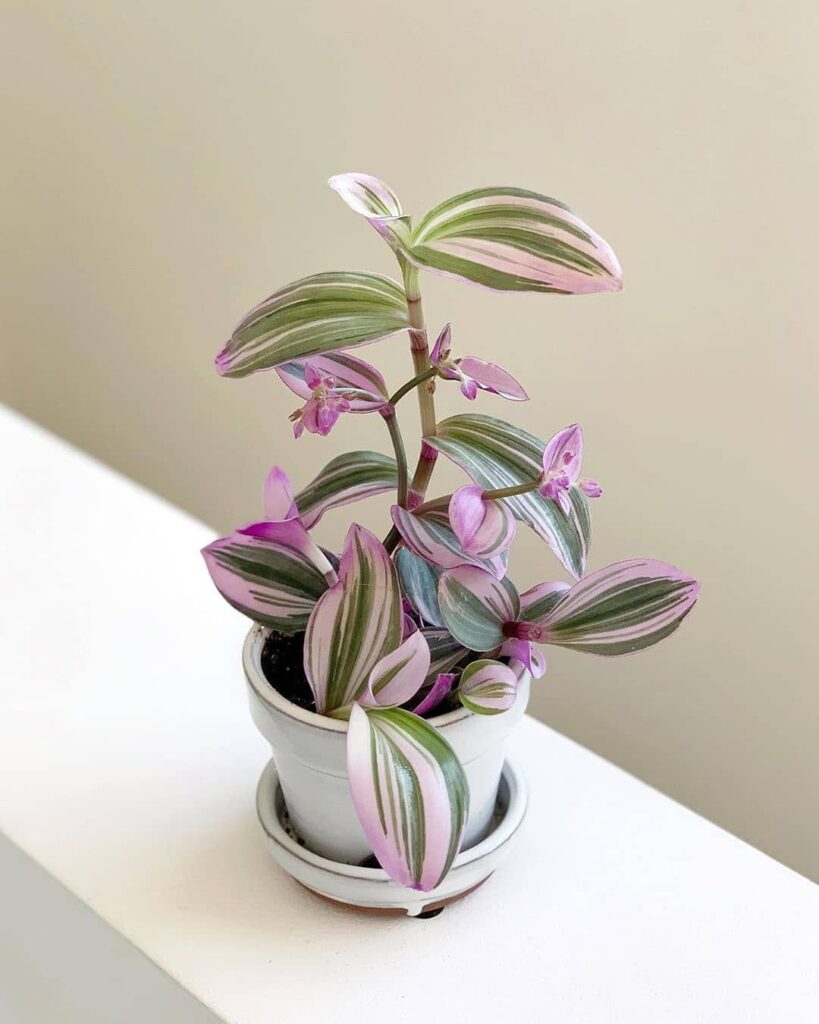
Hanging Basket Nanouks
This is how they grow in hanging baskets! Amazing beauty where you get the angle to see the underneath of the leaf more because it is suspended in the air.
Tradescantia FAQ’s
It is very easy to care for and hard to kill. Give it plenty of indirect bright light and water once the top of the potting soil goes dry. Tradescantia enjoys humidity. In winter months you can water less frequently which makes it a great houseplant for the busy person.
Brown leaf tips are lack of humidity or direct sun too long. Yellow leaf could be a bacteria issue but it’s probably just too much moisture or the plant soil is not draining. This can lead to root rot from sitting in water for too long. If this is the case just allow the soil to dry out and stop watering it. At this point you may consider fresh soil and repotting into a well draining soil with plenty of perlite mixed in.
Simply pinch it back. Trim the branches just above the node or knobby part of the stem. Don’t worry because behind each current leaf there is a node where a new leaf will emerge causing the new growth to bush out rather than get leggy. You can also take the cuttings and place them in the soil with at least one node under the top of the soil where it will begin to root. This process may take a month but you just fixed your problem.
Water only when the top of the soil gets dry. It is a succulent and it can go weeks without water. Going that long with water is not advised but your Tradescantia is capable of surviving extended periods without water.
This simply means not to place your Tradescantia in the direct sunlight. Keep it in a room that is bright during the day. If you lack bright light then a simple grow light will work but keep it at a good distance and not right up on the plant as it will scorch the leaves.
Yes, once established, a Tradescantia can be somewhat aggressive. The growing conditions and time of year play a role in how fast it will grow. In nature it is a creeping ground cover.
Studies have shown that the plant contains an irritant in its sap and if ingested it is toxic for a pet. However, we have not seen any records of a pet dying due to a run in with Tradescantia. At worst, you may notice an allergic skin reaction and mild complications for even the handler. So keep the plant away from your pets. Always wash your hands after coming in contact with the plant.
How Fast does Tradescantia Grow?
The answer is really fast. If you want to give your plant a good boost just water it!! Really, in the Spring keep the soil watered and it will take off.
If you want it to grow slower let the soil dry out. Tradescantia has similarities to succulents, it can handle dry soil conditions well in the winter months.
Why is my Tradescantia Leggy?
This could be due to a couple of issues. First, you want your plant in a light area and not to be dark all day. It needs at least eight hours of light per day.
Second, you need to prune it. By pruning and clipping off the leggy long stems it will cause the plant to branch rather than trailing. Then filling it out for you.
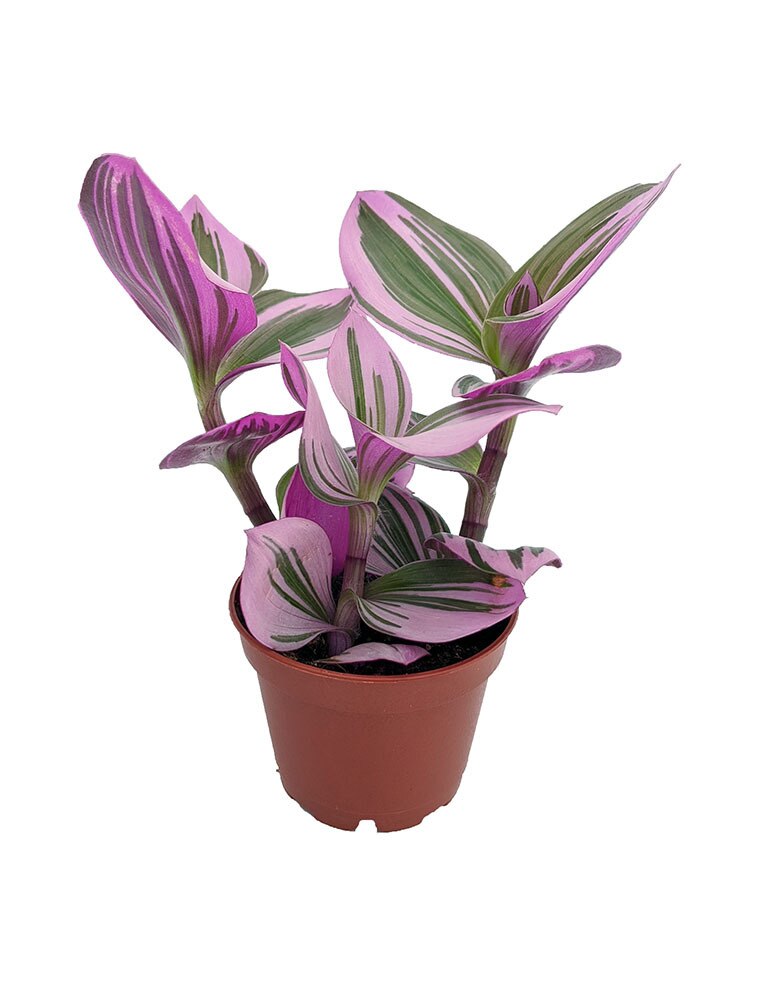
***Pro Tip – you can transplant your Tradescantia Pink Nanouk cuttings into the planter to help fill it out too.
After a few weeks the cutting should start to root inside the soil of the pot. This is a quick way to fill in a bare spot inside your house plant planter.
Why is my Tradescantia Turning Brown?
One reason your Tradescantia is turning brown is due to damage done by bruising or insects.
Something has possibly run into your plant and now you are seeing “bruising” taking place.
Insects like slugs can be in your potting mix, slugs will leave streaks and holes with brown spots as well.
Browning could also be a way that your Nanouk is telling you “too much water” causing rot to set in.
Let your potting mix dry out in the pot for a week or so if your soil is too wet.
Why is my Nanouk Dying?
3 reasons your Nanouk will want to die. First, not enough filtered light and too cold.
The right conditions need to be met for the Tradescantia to thrive. Remember 8 hours of light and temps above 55 degrees F.
Second, you are watering it too much. Let the top layer of soil dry out before watering again.
Keeping the soil too wet will cause your plant to rot and die.
Lastly, too rich of soil. Do not over fertilize your Tradescantia Pink Nanouk. The nanouk is self-containing really.
It doesn’t need much on the scientific fertilization side. Just let it do its thing when in doubt. Do not add any fertilizer if you are unsure of what you are doing.
It’s better not to add anything at all.
Why is my Tradescantia Turning Yellow?
Your Tradescantia nanouk turns yellow when the leaves are about to fall off.
If all the leaves are turning yellow then you have possibly a bacterial issue in the soil or the soil has been too wet for too long.
You can try to save your plant by repotting it into new soil that is moist but not wet.
Let the soil dry out for a week then begin to water slowly but less is more in this case. A little water goes a long way.
Is Tradescantia Toxic to Dogs?
Yes, if consumed a dog may become sick and throw as it will irritate their throat if swallowed.
Is Tradescantia Toxic to Cats?
Yes, The plant has sap within the stems that will bother your cat’s digestive tract. It’s important to note that usually there isn’t a toxic reaction
What Parts Of The Wandering Jew (Tradescantia) Plant Are Poisonous or Toxic?
The sap of most members of the Tradescantia genus is irritating to the skin.
The American Society for the Prevention of Cruelty to Animals ASPCA does not specifically list Tradescantia zebrina as toxic, and it does list a close relative, Tradescantia fluminensis (which also goes by the common name, Wandering Jew) as being a skin irritant to cats, dogs, and horses.
What Are The Symptoms Of Poisoning?
The sap can cause dermatitis in people, dogs, cats, horses, and other living things.
It is unclear whether ingesting the sap would cause serious effects, but at a bare minimum, it would surely cause irritation of the mouth and throat.
Although there is little information regarding the effects of Wandering Jew when ingested, it is worth noting the sap of this plant and its leaves are used in a wide variety of folk medicines in many parts of the world.
More Information About Tradescantia Pink Nanouk

They love humidity because are found in nature around the tropics. Also, warm weather and humid air does them well.
Is Tradescantia Invasive?
Only one species is considered invasive in Florida.
According to the USDA Plants Database there is only one species of Tradescantia that occurs as an introduced naturalized species, Tradescantia fluminensis (Small-leaf spiderwort). It is a native of South America and in Florida it is considered invasive.
Propagating Tradescantia Nanouk
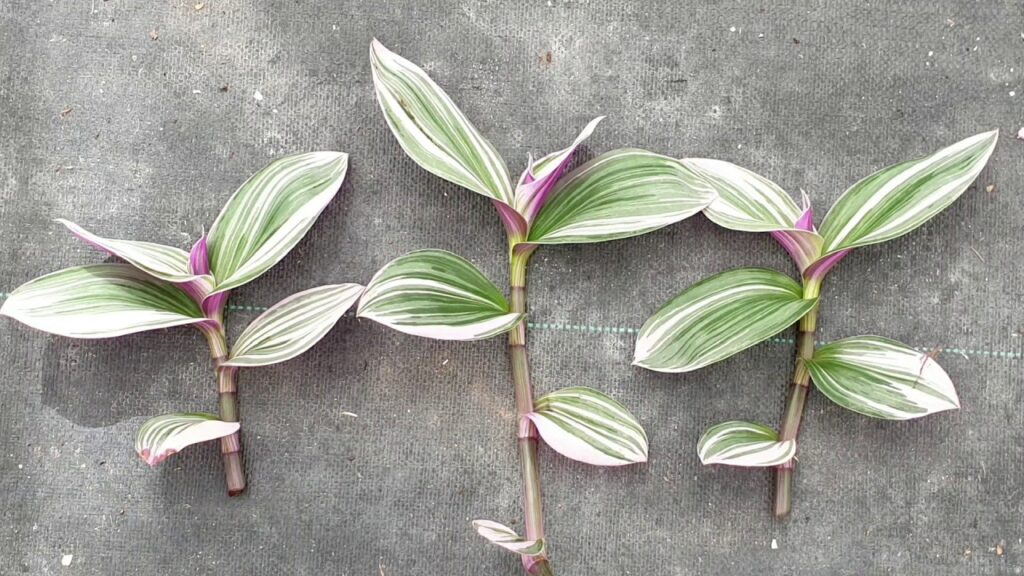
Tradescantia nanouk propagation
Tradescantia nanouk propagation is easy. Use a pair of clean plant shears but cut below a node on a stem that has a few leaves.
Also, remove any of the lower-most leaves to leave a few inches of bare stem.
Place the cutting in a jar of water so that at least a few nodes are below the surface.
Put the jar somewhere that receives bright, indirect light so it can thrive. After about a week you should see tiny roots sprouting.
Also, replace the water once a week when it looks or smells grimy. Also, top it off when the water level gets lower.
Within a few weeks, your cutting should be ready to transfer into its permanent pot.
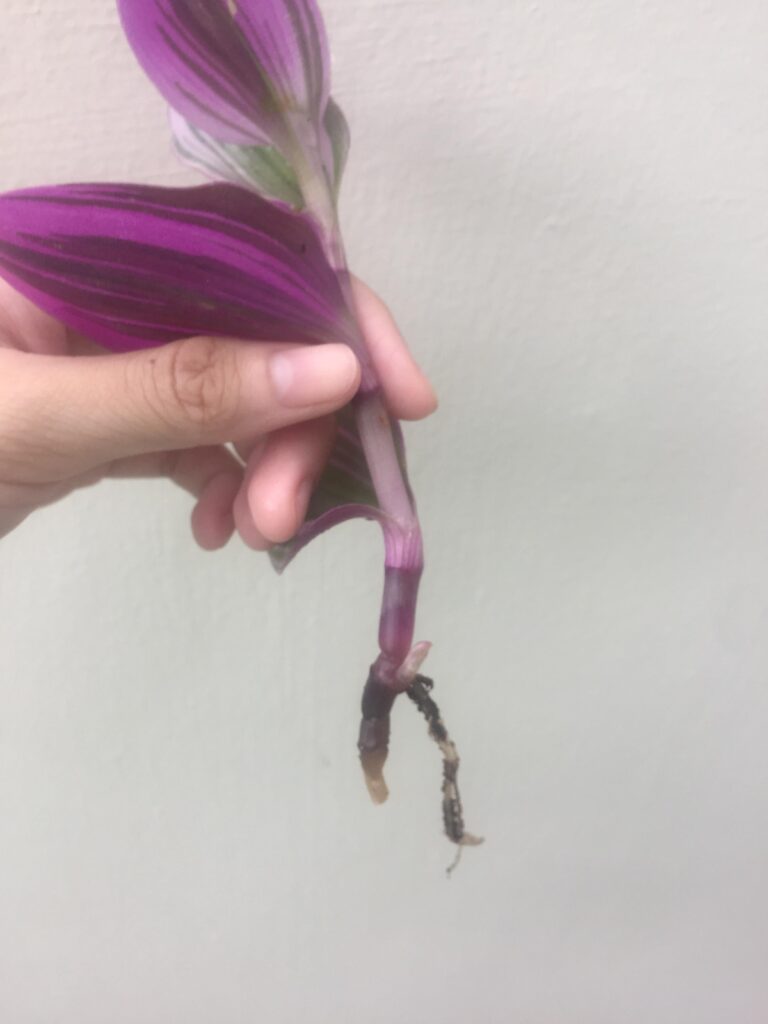
Other Tradescantias That We Grow
Secreasea Pallida ‘VARIEGATA’ is another Fast growing mounding house plant and cascading plant with long lance-shaped leaves with pink and purple stripes.
Pink Nanouk Video
Tradescantia nanouk
Also known as, Tradescantia fluminensis ‘Nanouk‘
You can propagate Tradescantia Nanouk, also known as “bubblegum” and it’s very easy!
You can propagate your Nanouk in water or directly into soil. I’ll describe both below.
As a reminder, a node is where leaves and roots grow out of the stem, you’ll see lines along the stem of this plant just below the leaves that indicate where a node is.
Tradescantia nanouk Flower
Tradescantia nanouk flower. Yes, some may ask does tradescantia nanouk flower? Yes, it is small and white to pink color. It has three petals and three sepals.
The buds are purple-pink, opening into blooming white or pink flowers, which may bloom throughout the growing season and from spring to the end of summer.
Tradescantia nanouk is known for this gorgeous variegation. The foliage on the plants are a mix of light green, light purple, and cream but some people don’t even know that it flowers!
Is Tradescantia nanouk a Succulent
Tradescantia, also known as the inch plant, and is native to North and South America.
There are around 60 species, of which most are hanging plants, although there are also a few that grow upwards. Although it’s not a succulent, the stems are able to store a fair amount of water and are similar in that way.
Conclusion
So overall the Pink Nanouk is a great houseplant to grow in your home. We have discussed how easy this is to grow and care for.
Would you grow this plant in your home?


